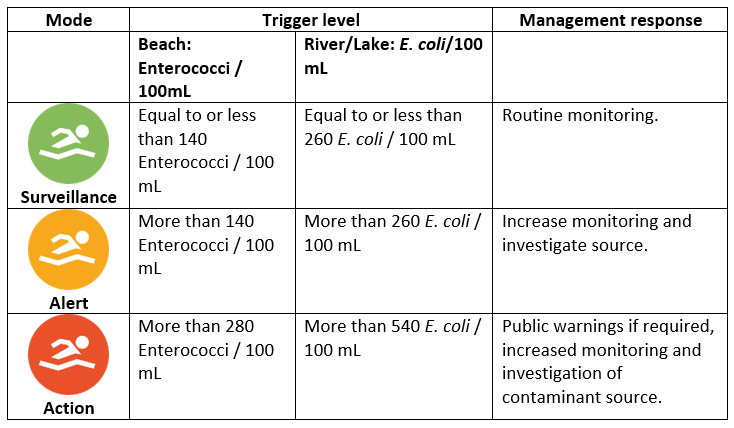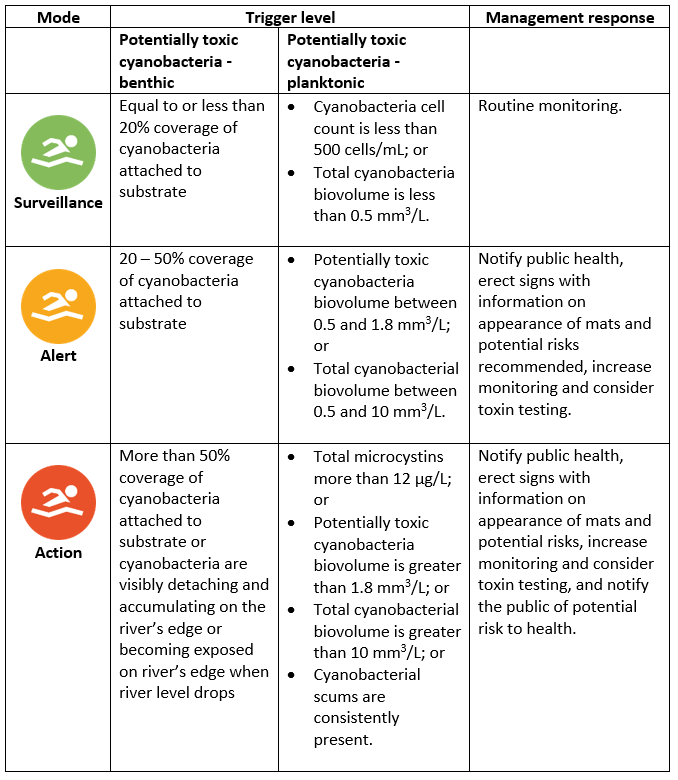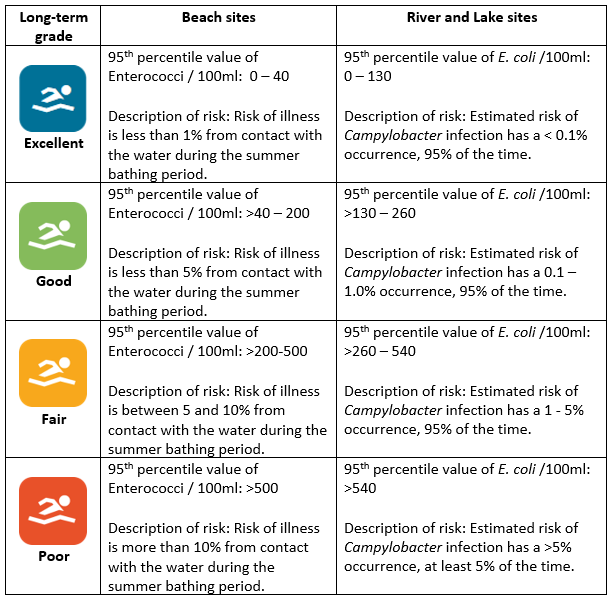During the swimming season (around November/December to February/March), regional, unitary, district and city councils, along with public health agencies, assess the health risks from faecal (‘poo’) contamination at swimming spots. Toxic algae is also regularly monitored at some river and lake sites.
LAWA displays the results of the recreational monitoring. We check for new data regularly throughout the day, and warnings are posted by authorities, ensuring you have the most up-to-date information on the water quality at swim sites across Aotearoa New Zealand.
Why can water cause illness?
When water is contaminated by human or animal faeces (‘poo’), it can contain disease-causing bacteria, viruses and protozoa (such as salmonella, campylobacter, or giardia). These organisms can pose a health risk in water that is used for recreational activities, such as swimming. The most common illness is gastroenteritis, but respiratory illnesses, ear infections and skin infections may also occur.
Water quality for swimming is assessed by measuring 'faecal indicators' (enterococci in coastal waters and E. coli in rivers and lakes), which are used to indicate the levels of disease-causing organisms in the water. For more information, see this factsheet on faecal indicator bacteria.
Toxic algae (cyanobacteria) can become a problem in some lakes and rivers when present in large amounts, known as toxic algal blooms. Some species of cyanobacteria can produce toxins, but they are not always toxic. For more details, see this factsheet on toxic algae.
What does the summer recreational season monitoring information tell us?
For most sites, LAWA shows the recent water quality result along with data from the last five years of sampling during the recreational bathing season, which is used to determine the long-term grade.
The recent result, monitoring history and long-term grade, along with any warnings or advice from authorities, can help guide your decision on where it is suitable to swim. For more details, refer to the What do the swim icons mean? and Swim Smart Checklist factsheets.
Weekly sampling & predicted water quality results
Faecal indicator bacteria
Most councils monitor the water quality weekly during the summer months to inform the public about any risks from contact with the water. The weekly sample result provides a recent snapshot of the water quality at the time of testing. However, it is important to note that water quality can change over time, particularly after rain. This is why, even at sites with generally good water quality, we recommend avoiding swimming for 2-3 days after heavy rainfall, as urban or agricultural run-off can affect bathing water quality.
In the Northland, Auckland and Wellington regions, water quality at many sites is predicted using models. These predictions of water quality are regularly updated to provide a 'real-time' assessment. The models vary in complexity: simpler models consider factors such as water quality history and rainfall, while more advanced models also account for tides and storm water overflows to determine the predicted water quality risk.
National guidelines for faecal indicator bacteria (2003 Microbiological Water Quality Guidelines for Marine and Freshwater Recreational Areas and the National Policy Statement for Freshwater Management (2020) for freshwater sites) provide trigger levels that allow councils to assess individual monitoring results and determine when management intervention is required. The trigger levels and corresponding management responses are shown in the table below.

When water quality falls in the ‘surveillance’ category, it indicates a low risk of illness from swimming. If water quality moves into the ‘alert’ category, it indicates an increased risk of illness from swimming, though still within an acceptable range. However, if water quality reaches the ‘action’ category, it poses an unacceptable health risk from swimming.
Note that under the 2003 guidelines, health warnings for coastal waters are only issued after two consecutive samples (within 24 hours) exceeds the ‘action’ trigger level.
Toxic algae (cyanobacteria)
The risk to people and animals from toxic algae is assessed by measuring the extent of cyanobacteria coverage on the river bed, the amount of cyanobacterial mats washed up on the riverbank, or the concentration of cyanobacteria suspended in the water column in lakes or slow-flowing waterways.
Results are compared to national guidelines for toxic algae (New Zealand Guidelines for Cyanobacteria in Recreational Fresh Waters: interim guidelines*), which provide trigger levels that allow councils to assess individual monitoring results and determine when management intervention is needed. The trigger levels and corresponding management responses are shown in the table below.

*New guidelines, released on 5 December 2024, outline an updated monitoring framework for assessing public health risks from cyanobacteria associated with recreational activities in lakes and rivers. These guidelines will be progressively implemented by agencies responsible for monitoring and reporting on recreational waterways.
Not all recreational sites are monitored for toxic algae. Since it can be harmful, even in small amounts, we recommend learning what it looks like, and avoiding contact when you see it. For more details, see this factsheet on toxic algae.
Long-term grade
The long-term grade is a precautionary guide to general water quality, assessing whether a site is excellent, good, fair or poor for swimming during the recreational bathing season. Updated annually, it is calculated from faecal indicator bacteria data (E. coli for freshwater or enterococci for coastal waters). This overall grade is risk-based and may not reflect conditions on a particular day.
The long-term grade aligns with the Microbiological Assessment Category (MAC) in the Microbiological Water Quality Guidelines for Marine and Freshwater Recreational Areas for coastal sites, and the attribute bands (table 22) in the National Policy Statement for Freshwater Management (2020) for freshwater sites.

What does this mean in practice?
- Sites graded as excellent, good, or fair typically have suitable water quality for swimming more often than those graded as poor over the past five summers.
- The poor category encompasses a range of water quality results, from sites that occasionally exceed guidelines to those with a history of repeated or ongoing exceedances.
- Many popular swimming spots exceed guidelines after adverse weather conditions but are often suitable for swimming outside these times. That’s why we recommend avoiding swimming for 2–3 days following heavy rain, regardless of the recent monitoring result or long-term grade.
- When deciding where to swim, a ‘poor’ grade should prompt you to look closer at the data under ‘Why this status?’ on the site page to understand how the swim spot has performed over time.
How is the long-term grade calculated?
The long-term grade on LAWA is based on the Hazen 95th percentile of sample results from the last five recreational bathing seasons. In simple terms, if a site has a 95th percentile of 200, it means that 95 out of 100 times the results were at or below 200 E. coli/100 mL (freshwater sites), or 200 enterococci/100 mL (coastal beaches) when tested.
Notes on the analysis:
- Samples are from the recreational bathing season (last week of October to the end of March).
- Data from the past five recreational bathing seasons (2019/20 to 2023/24) are used to represent weather conditions over several summers.
- Weekly routine sampling results are used. Data from follow-up samples taken in response to elevated results are excluded where councils provide metadata that identify follow-up samples.
- At least 50 sample results over the last five seasons are required, and the site must be part of a recent monitoring programme.
- Sites not routinely monitored in either of the last two bathing seasons (2022/23 and/or 2023/24) are excluded, even if they had at least 50 data points.
- For estuarine sites monitored for both enterococci and E. coli, we apply a precautionary approach by assigning the worst result from the two bacterial indicators.
- Toxic algal data or other factors such as swift river or tidal flows that might make a site unsuitable for swimming are not included.
Impact of wet weather on monitoring and analyses:
Wet weather can cause bacteria to flow from land into rivers and streams, which can influence bacteria counts and lead to higher counts in wet summers. Some councils account for the influence of rainfall by limiting sampling to dry weather conditions when people are more likely to swim. Other councils remove rainfall-related bacteria results before calculating the 95th percentile, so the data may better reflect typical swimming conditions. Health and safety considerations may also restrict when sampling can be undertaken during wet weather. Because there is no standardised national method for adjusting rainfall-related sample data, no adjustments have been made to data presented on LAWA. All routine sample results, regardless of weather conditions, have been used in the long-term grade calculations.
FAQ
What is the impact of rainfall?
Rainfall can significantly affect water quality at river, lake and beach swimming spots due to urban or rural runoff. In urban areas rainwater collected from roofs, roads, car parks and other surfaces is piped directly into rivers, streams and coastal waters. Along the way, the stormwater picks up sediment, rubbish, contaminants, and droppings from birds and dogs. Sewer overflows may also occur during wet weather in urban areas.
In rural areas, excess rainwater flows over the land and into nearby streams and rivers, picking up manure and other contaminants.
Additionally, at some river, lake and coastal sites, heavy rain and wind can churn up sediments from the bottom, releasing pathogens in the sediments back into the water.
Why can the weekly monitoring result be 'suitable for swimming' when the long-term grade is 'poor'?
A 'poor' long-term grade indicates an elevated risk of illness compared to sites with better grades. However, the most recent samples can still show water quality within acceptable limits for swimming. The long-term grade is based on data from the past five bathing seasons, which may include results affected by heavy rainfall, high river flows, or bacteria contamination from storm water run-off or sewer overflows (in both dry and wet weather).
For sites with a 'poor' grade, you should review the historical data to see if monitoring results frequently exceed guidelines. If exceedances are common, it is best to choose another place to swim.
Some sites may be graded 'poor' because, while most test results passed, a few exceeded the guidelines - sometimes significantly. For these sites, if the most recent results meet swimming guidelines, the water looks clean and clear, there hasn't been recent heavy rainfall, and no pollution sources are evident, or warnings are posted, it's likely the water quality is still suitable for swimming. For more information about a specific site, contact the council responsible for monitoring.
What other risks are not accounted for?
Swimming at your favourite beach, river or swimming hole involves additional safety risks not captured in water quality monitoring. Weekly testing at some river and lake sites does include checks for toxic algae (cyanobacteria) which may be harmful if ingested (young children who put things in their mouth are most at risk), there may be unexpected pollution events, or the presence of other hazards like strong river flows or tidal currents, steep drop-offs, underwater objects or stinging jellyfish.
Additionally, there may be unmonitored contaminants that can make the water unsuitable for swimming. Always consider these risks and use caution when swimming.
The roles and responsibilities of agencies
Monitoring of recreational water quality involves multiple agencies: regional councils, district and city councils and health agencies. The roles and responsibilities can vary in each region but most follow those recommended by the Microbiological Water Quality Guidelines for Marine and Freshwater Recreational Areas.
The regional councils and unitary authorities are responsible for implementing a monitoring programme. This includes:
- Weekly sampling at popular swimming sites
- Investigations of sources of contamination
- Informing the Medical Officer of Health (Community and Public Health) and the local district or city council if alert or action levels are reached
- Collating information for annual reporting and for grading of sites.
The Medical Officer of Health at Community and Public Health is responsible for:
- Reviewing the effectiveness of the monitoring and reporting strategy
- Ensuring the territorial authority is informed
- Ensuring the territorial authority informs the public of any health risks.
The district or city council is responsible for:
- Informing the public when the action level is exceeded
- Assisting with identifying sources of contamination
- Implementing steps to abate or remove any sources of contamination.
In addition, under the National Policy Statement for Freshwater Management (2020), regional councils and unitary authorities are required to take practicable steps to notify the public when designated freshwater primary contact sites exceed 540 E. coli per 100 mL during the bathing season.
Find out more
- Visit the Can I swim here? topic for monitoring results and information at recreational swim sites across New Zealand
- For further information about recreational monitoring programmes in a region or water quality conditions at a specific site, contact the local regional or unitary council.
